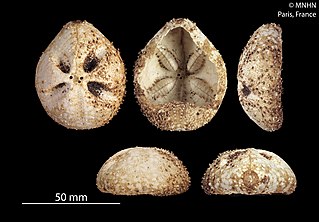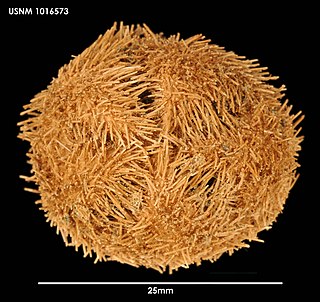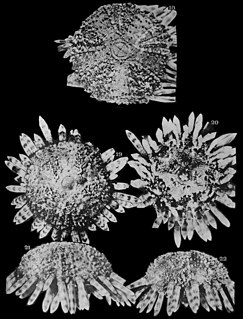
Temnopleuridea is an infraorder of sea urchins in the order Camarodonta. They are distinguished from other sea urchins by the presence of large fused plates on top of the feeding lantern. The test is usually sculpted to some degree, and has perforated tubercles.

The Echinothurioida are an order of sea urchins in the class Echinoidea. Echinothurioids are distinguished from other sea urchins by the combination of a flexible test and hollow spines. The membrane around the mouth contains only simple plates, in contrast to the more complex mouth parts of their close relatives, the Diadematoida. They are nearly all deepsea dwellers.

The Camarodonta are an order of globular sea urchins in the class Echinoidea. The fossil record shows that camarodonts have been in existence since the Lower Cretaceous.

Amphipneustes davidi is a species of sea urchin of the family Temnopleuridae. Their armour is covered with spines. It is placed in the genus Amphipneustes and lives in the sea. Amphipneustes davidi was first scientifically described in 2010 by Madon-Senez.

Amphipneustes koehleri is a species of sea urchin of the family Temnopleuridae. Their armour is covered with spines. It is placed in the genus Amphipneustes and lives in the sea. Amphipneustes koehleri was first scientifically described in 1905 by Ole Mortensen.

Amphipneustes similis is a species of sea urchin of the family Temnopleuridae. Their armour is covered with spines. It is placed in the genus Amphipneustes and lives in the sea. Amphipneustes similis was first scientifically described in 1936 by Ole Mortensen, Danish zoologist.
Aporocidaris antarctica is a species of sea urchin of the family Ctenocidaridae. Their armour is covered with spines. It is placed in the genus Aporocidaris and lives in the sea. Aporocidaris antarctica was first scientifically described in 1909 by Ole Theodor Jensen Mortensen, Danish professor. It has a circum-Antarctic distribution.
Araeosoma belli is a species of sea urchin of the family Echinothuriidae. Their armour is covered with spines. It is placed in the genus Araeosoma and is found throughout the Caribbean Sea as well as areas around the Gulf of Mexico. Araeosoma belli was first scientifically described in 1903 by Ole Theodor Jensen Mortensen, a Danish zoologist.
Araeosoma violaceum is a species of sea urchin of the family Echinothuriidae. Its armour is covered with spines. It is placed in the genus Araeosoma and lives in the sea. A. violaceum was first scientifically described in 1903 by Ole Theodor Jensen Mortensen.

Arbaciella elegans is a species of sea urchin of the family Arbaciidae. Their armour is covered with spines. It is placed in the genus Arbacia and lives in the sea. Arbaciella elegans was first scientifically described in 1910 by Ole Theodor Jensen Mortensen.
Breynia elegans is a species of sea urchins of the Family Loveniidae. Their armour is covered with spines. Breynia elegans was first scientifically described in 1948 by Ole Theodor Jensen Mortensen.

Chaetodiadema granulatum is a species of sea urchins of the Family Diadematidae. Their armour is covered with long and slender spines, and the test is quite flattened.
Chaetodiadema japonicum is a species of sea urchins of the Family Diadematidae. Their armor is covered with spines. Chaetodiadema japonicum was first scientifically described in 1904 by Ole Theodor Jensen Mortensen.
Cidaris nuda is a species of sea urchins of the Family Cidaridae. Their armour is covered with spines. Cidaris nuda was first scientifically described in 1903 by Ole Mortensen.

Chaetodiadema is a genus of sea urchins of the Family Diadematidae. Their armour is covered with spines.

The Echinothuriidae are a family of sea urchins in the order Echinothurioida. Due to their soft skeletons, most are called "leather urchins", but species in the genus Asthenosoma are also known as "fire urchins" due to their bright colors and painful, venomous sting.

Gracilechinus is a genus of sea urchins in the family Echinidae.

Araeosoma is a genus of deep-sea sea urchins in the family Echinothuriidae.

Fibularia is a genus of echinoderms belonging to the family Fibulariidae. The genus has almost a cosmopolitan distribution.
Calocidaris is a genus of echinoderms belonging to the family Cidaridae.












